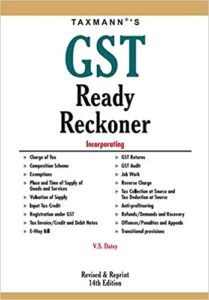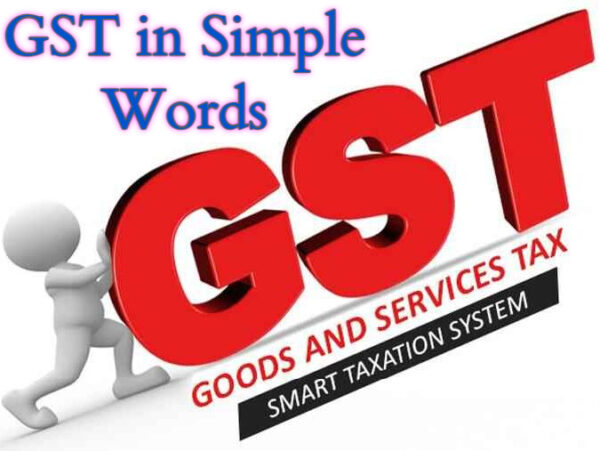Contents
What is GST ( Goods & Service Tax )in Simple Words?
GST( Goods & Service Tax) in simple words is a destination-based tax on the consumption of goods and services. It is proposed to be levied in the least stages right from manufacture up to final consumption with credit of taxes paid at previous stages available as depart.
In a nutshell, only value addition is going to be taxed and therefore the burden of tax is to be borne by the ultimate consumer. The concept of destination-based tax on consumption implies has the tax would accrue to the taxing authority which has jurisdiction over the place of consumption which is also termed as the place of supply. It is also called one Country one tax.
GST in simple words features a twin factor with the Centre and States concurrently levying on a frequent assets . There are three primary factors of GST which are CGST, SGST, IGST capability Central Goods and Services Tax.
Types of Taxes under GST in Simple Words
- CGST:
Taxes collected under CGST will represent the revenues of the Central Government. The present central taxes like central excise duty, extra excise duty, one-of-a-kind excise duty, central income tax, etc., will be subsumed below CGST. SGST ability State Goods and Services Tax.
- SGST:
A series of SGST is the income of the State Government. With GST all kingdom taxes like VAT, amusement tax, luxurious tax, entry tax, etc. will be merged. For example, Ramesh a supplier in Punjab sells items to Seema in Punjab well worth Rs. 10,000. If the GST fee is 18%, i.e., 9% CGST and 9% SGST, Rs. 900 will go to the Central Government and 900 will go to the Punjab Government.
- IGST:
IGST means Integrated Goods and Services Tax. Revenue collected under IGST is split between the Central and the government as per the rates specified by the govt. IGST is charged for the transfer of products and services from one state to a different one. Import of products and services also are covered under IGST.
For example, if the products are transferred from Madhya Pradesh to Rajasthan then this transaction will attract IGST. Let us extend the above example to know SGST. If Ramesh in Bihar sells goods to Anand in Rajasthan worth Rs. 1,000,000. THE Applicable GST rate is eighteen i.e., 9% CGST and 9% SGST. In this case, the dealer will charge 18,000 as IGST and can attend the Central Government.
How is GST Input Works
Now understand what is the input tax credit in GST. In simple terms, the Concept of GST is such that the last consumer of the goods or services will be charged GST and the entire GST will be burdened with it. So, keeping this in view, the traders have been given the facility of Tax Credit so that the burden of tax generated in the transactions does not come to them. Understand this from an example –
| Transaction | Amount of Product | GST 18% | GST Input |
| Suppliers sold the mobile to the Distributor ( 3000/-) | 2542/- | 458/- | 458/- |
| The distributor sold the mobile to Retailor ( 4000/-) | 3390/- | 610/- | 152/- ( Balance Rs.458 Tax Input to Distributor) |
| The retailer sold the mobile to Consumer ( 5000/-) | 4237/- | 763/- | 153/- ( Balance Rs.610 Tax Input to Retailor) |
The consumer will be paid Rs.5000 and the government will be collecting GST amt Rs. ( 458+152+153=763/-).
Characteristics of G S T in Simple Words
I) GST is a common law and procedure throughout the country under a single administration.
II) GST is a destination-based tax levied at a single point at the time of consumption of goods and services by the end consumer.
III) GST is a comprehensive levy and collection of both goods and services at the same rate with the benefit of input tax credit or subtraction of value.
IV) The minimum number of rates of tax does not exceed two.
V) There is no scope for the levy of cess, resale tax, additional tax, turnover tax, etc.
VI) There are no multiple levies of tax on goods and services, such as sales tax, entry tax, octroi, entertainment tax, luxury tax, etc.
Advantages of G S T in Simple Words
I) The introduction of GST has resulted in the abolition of more than one sort of tax on goods and services.
II) GST widens the tax base and increases revenue to the Centre and State thereby reducing administrative costs for the Government.
III) GST has reduced compliance costs and increased voluntary compliance.
IV) GST has affected rates of tax to the utmost of two-floor rates.
V) GST has removed the cascading effect on taxation.
VI) GST will end in enhancing the manufacturing and distribution system affecting the value of production of products and services and consequently, the demand and production of products and services will increase.
VII) It will eventually promote economic efficiency and sustainable future economic processes as GST is neutral to business processes, business models, organizational structure, and geographical location.
VIII) GST would help to extend the competitive edge in the international market for goods and services produced in the country leading to increased exports.
Taxmann’s Ultimate Best-Seller ‘GST Ready Reckoner’, authored by Mr V.S. Datey, is a ready reference for all provisions of the GST Law. It covers all important topics of GST along with relevant Case Laws, Notifications, Circulars, etc. The Present Publication is the 14th Edition & Updated till 1st November 2020. This book follows the Six Sigma approach to achieve the benchmark of zero error.


Leave a Reply